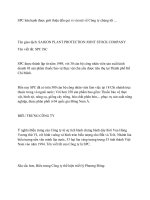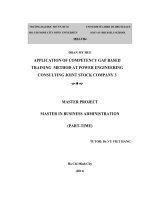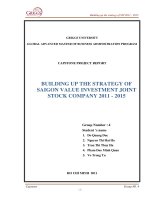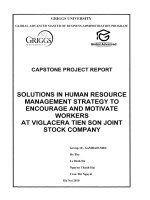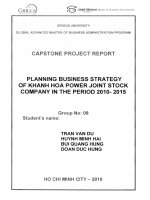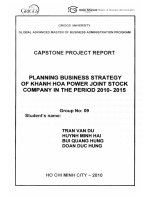Job stress in sales department at saigon plastic packaging joint stock company
Bạn đang xem bản rút gọn của tài liệu. Xem và tải ngay bản đầy đủ của tài liệu tại đây (1.41 MB, 68 trang )
UNIVERSITY OF ECONOMICS HO CHI MINH CITY
International School of Business
------------------------------
Lê Thị Đoan Hạnh
JOB STRESS IN SALES DEPARTMENT
AT SAIGON PLASTIC PACKAGING
JOINT STOCK COMPANY
MASTER OF BUSINESS ADMINISTRATION
SUPERVISOR: Ph.D. NGUYEN PHONG NGUYEN
Ho Chi Minh City – Year 2018
CONTENTS
LIST OF TABLES .........................................................................................................5
LIST OF FIGURES .......................................................................................................6
CHAPTER 1 ...................................................................................................................7
1. Company background .........................................................................................7
1.1 History of company ............................................................................................7
1.2 Mission and Vision ............................................................................................8
1.3 SAPLASTIC.JSC organization chart (Appendix 1) .........................................8
1.4 SAPLASTIC.JSC Sales department chart (Appendix 2)..................................8
2. Symptom...............................................................................................................8
2.1 Symptom description ..........................................................................................8
2.1.1 High turnover rate ..........................................................................................8
2.1.2 Low sales revenue .........................................................................................10
2.2 Symptom consequences ...................................................................................11
3. Initial cause effect map .....................................................................................13
3.1 High goal expectation ......................................................................................13
3.2 Job Stress ..........................................................................................................15
3.3 Low compensation and benefits ......................................................................15
4. Updated cause effect map .................................................................................16
5. Potential central problems ................................................................................19
CHAPTER 2 .................................................................................................................22
1. Problem definition .............................................................................................22
2. Problem existence ..............................................................................................23
2.1 Work pressure ..................................................................................................25
2.2 Working environment ......................................................................................26
2
2.3 Career development opportunities...................................................................28
2.4 Personal relationship .......................................................................................29
2.5 Conflic between work – life roles ....................................................................31
3. Problem importance ..........................................................................................33
3.1 The studies relate to job stress consequences. ................................................33
3.2 The consequences of job stress affects to SAPLASTIC.JSC .........................35
3.2.1
Performance consequence .......................................................................35
3.2.2
The increasing of customer complaint ....................................................36
3.2.3
Higher training and hiring cost ...............................................................37
3.2.4
The employees go to work late and ask for day-off frequently ...............38
CHAPTER 3 .................................................................................................................40
1. Causes validation ...............................................................................................40
1.1
Work pressure ..............................................................................................40
1.2
Working environment ..................................................................................40
1.3
Career development opportunities ..............................................................41
1.4
Personal relationship ...................................................................................41
1.5
Conflict between Work-Life roles ...............................................................41
2. Solution ...............................................................................................................41
2.1
Work pressure ..............................................................................................41
2.2
Working environment ..................................................................................43
2.3
Career development opportunities ..............................................................44
2.4
Personal relationship ...................................................................................44
2.5
Conflict between Work-Life roles ...............................................................46
APPENDIX 1 - SAPLASTIC.JSC ORGANIZATION CHART .............................47
APPENDIX 2 - SAPLASTIC.JSC’s SALES DEPARTMENT CHART ................48
3
APPENDIX 3 – IN-DEPTH INTERVIEW – ROUND 1 .........................................49
APPENDIX 4 – IN-DEPTH INTERVIEW – ROUND 2 .........................................53
APPENDIX 5 – QUESTIONAIRE – ENGLISH VERSION ...................................57
APPENDIX 6 – QUESTIONAIRE – VIETNAMESE VERSION ..........................60
APPENDIX 7 – SURVEY RESULT COLLECTION ..............................................63
REFERENCES ............................................................................................................65
4
LIST OF TABLES
Table 1. 1 - Statistics of changes in human resources in the Sales department of
SAPLASTIC.JSC for the period of 2015 - 2017.....................................................................8
Table 1. 3 - Business plan of SAPLASTIC.JSC for the period of 2015 – 2017 ...........14
Table 2. 1- External expressions of stress ..................................................................... 23
Table 2. 2 - Observation variables define Job stress causes at SAPLASTIC.JSC ........24
Table 2. 3– Summary of complaint cases from customers ...........................................36
Table 2. 4 - Training and hiring cost of salesman in SAPLASTIC.JSC in 2015 – 2017
.......................................................................................................................................37
Table 2. 5 - Statistics of hours that staff go to work late and the number of vacations of
sales department in SAPLASTIC.JSC ..........................................................................38
5
LIST OF FIGURES
Figure 1. 1 - Chart of statistics of changes in human resources in Sales department of
SAPLASTIC.JSC for the period of 2015 - 2017 .............................................................9
Figure 1. 2 - Revenue Results at SAPLASTIC.JSC for the period of 2015 - 2017 .....10
Figure 2. 1 - Measurement of work pressure factors .................................................... 25
Figure 2. 2 - Evaluation of working environment factors ............................................26
Figure 2. 3 - Evaluating opportunities for career development ....................................28
Figure 2. 4 - Evaluating personal relationship factors ..................................................29
Figure 2. 5 - Evaluating the conflicting factors between work and life .......................31
6
CHAPTER 1
1. Company background
1.1 History of company
April 6th, 2001: was established with name Saigon Plastic Packaging Limited
Company as forerunner and started building factory in an area 5,208 m2.
February 2003, the factory had been finished, in turn the machinery was
invested, began with gravure printing machines, laminating, slitting and bag making
machines.
January of 2006, Saigon Plastic Packaging Limited Company was the first who
granted both quality management certificates ISO 9001:2000 and environment
management certificate ISO 14001:2004
In 2007, the company equitized and rename to Saigon Plastic Packaging Joint
Stock Company (SAPLASTIC.JSC)
September 2008, the share was officially listed on the stock market, as the code
SPP. SAPLASTIC.JSC has been invested by great investment fund, such as: BIDV
Investment, Vietnam Holdings, to name a few.
In the end of 2010, SAPLASTIC.JSC invested in setting up LAB department,
became first and only packaging company which had been equipped fully and
modernly equipment. This LAB was built with three functions: R&D activities input
material checking and output product control.
•
Công ty Cổ Phần Bao Bì Nhựa Sài Gòn
•
English name: SAIGON PLASTIC PACKAGING JOINT STOCK COMPANY
•
Trading name: SAPLASTIC.JSC
•
Tax code: 0302272627
•
Address: Lot II, 2B, Group V, Industrial Group II, Tan Industrial Zone, Tay Thanh
Ward, Tan Phu District, Ho Chi Minh City.
•
Business license: 0302272627 - Date of Issue: 10/05/2001
•
Operation date: 01/05/2001
•
Website:
•
Phone number: 028 3815 5263
•
General Director: Dương Quốc Thái
Fax: 028 3815 5262
7
•
Email:
1.2 Mission and Vision
Mission: Contribute to the stable development of Vietnamese brands in the
packaging industry, not only in South East Asia but also whole Asia Market, in order
to aim at the global market in future
Vision: Corporate vision for the period 2010 – 2030 is to build SAPLASTIC.JSC
to become the great interdisciplinary corporation. SAPLASTIC.JSC’s business base is
the stable development in association with eco-friendly and social responsibility.
1.3 SAPLASTIC.JSC organization chart (Appendix 1)
1.4 SAPLASTIC.JSC Sales department chart (Appendix 2)
2. Symptom
2.1 Symptom description
2.1.1 High turnover rate
Table 1. 1 - Statistics of changes in human resources in the Sales department of SAPLASTIC.JSC for the
period of 2015 - 2017
Targets
2015
2016
2017
Total Sales Staffs (Person)
17
21
27
Resigning Staff (Person)
New staff (Person)
Rate of increase (%)
3
5
2
66.67
9
4
80.00
17.65
23.81
33.33
Breakout Ratio / Total Sales Staff (%)
(Source: Administration & Human Resources department in SAPLASTIC.JSC )
8
Figure 1. 1 - Chart of statistics of changes in human resources in Sales department of
SAPLASTIC.JSC for the period of 2015 - 2017
RESIGNING STAFFS
9
5
3
2015
2016
2017
According to the figures above, the retirement status of employees at the Sales
Department of SAPLASTIC.JSC has increased steadily over the years 2015 - 2017.
In 2015, the total number of employees in the sales department of the company
is 17, with 3 employees retiring accounting for 17.65%.
In 2016, the total number of employees in the sales department of the company
increased to 21, corresponding to an increase of 4 people, corresponding to a 23.52%
increase over 2015. But this year the number of employees leaving the department is
up to 5 people, accounting for 23.81% compared with the total staff of the sales
department. The number of employees leaving the sales department increased to 5
people, corresponding to the increase of 2 people compared with 2015, corresponding
to the rate of increase of 66.67%. Thus, in 2016 SAPLASTIC.JSC has recruited 4 sales
staff to expand its business activities in the company's business plan. But this year the
number of salespersons leaving SAPLASTIC.JSC was higher than the number of
employees recruited by the company. This is quite dangerous and alarming situation in
the sales department of SAPLASTIC.JSC
In 2017, the total number of employees in the sales department of
SAPLASTIC.JSC increased to 27, in which 6 people are recruited by the company,
increasing by 28.57% compared to 2016. But the turnover status at the dales
9
department of SAPLASTIC.JSC is more serious when this year the number of
employees leaving is up to 9 people, accounting for 33.33%, corresponding to an
increase of 4 persons and an increase of 80% compared to 2016. Thus, the number of
employees recruited to the sales department SAPLASTIC.JSC is lower than the
number of employees leaving sales department. This proves that the current demand
for human resources in the sales department of the company is lacking and
significantly affecting the manufacturing and business activities of SAPLASTIC.JSC
in the past period.
2.1.2 Low sales revenue
Another alarming problem SAPLASTIC.JSC is facing is sales are tending to decrease,
as follows:
Unit: million VND
Targets
2015
2016
2017
Total revenue
426,511
548,254
Total cost
332,877
Profit before tax
93,634
2016/2015
2017/2016
+/-
%
+/-
%
448,963
121,743
28.54
(99,291)
(18.11)
422,699
369,771
89,822
26.98
(52,928)
(12.52)
125,555
79,192
31,921
34.09
(46,363)
(36.93)
(Source: Sales Department - SAPLASTIC.JSC)
Figure 1. 2 - Revenue Results at SAPLASTIC.JSC for the period of 2015 - 2017
Revenue
Cost
Profit before tax
125,555
93,634
79,192
422,699
369,771
332,877
426,511
548,254
448,963
2015
2016
2017
Looking at the table above, we see the business results of SAPLASTIC.JSC
fluctuating unevenly through the years 2015 - 2017. Specifically:
10
In 2015, total sales of the company reached VND 426,511 million, profit
reached VND 93,634 million.
In 2016, revenue increased to VND 548,254 million, equivalent to an increase
of VND 121,743 million, a 28.54% increase compared to 2015. The company's profit
also increased to VND125,555 million corresponding to an increase of VND31,921
million. The growth rate is 34.09% compared to 2015. It shows that in 2016, the
company's business performance still meets the target, the rate of the profit growth is
higher than the rate of revenue increase. In terms of the human resources of the sales
department at SAPLASTIC.JSC in 2016, the department has recruited 4 sales staffs
and 5 sales staffs retired. Thus, the problem of retirement of the sales staff at this time
did not significantly affect the sales revenue and profit of SAPLASTIC.JSC.
In 2017, the company's sales revenue fell to VND448,963 million, corresponding to a
decrease of VND99,291 million and a decrease of 18.11% compared to 2016. In
addition to decreasing sales, pre-tax profit also suffered and reduced to VND79,192
million, corresponding to a reduction of VND46,363 million, corresponding to a
decrease of 36.93% compared to 2015.
In 2017, the company's sales revenue fell to VND448,963 million,
corresponding to a decrease of VND99,291 million and a decrease of 18.11%
compared to 2016. In addition to decreasing sales, pre-tax profit also suffered and
reduced to VND79,192 million, corresponding to a reduction of VND46,363 million,
corresponding to a decrease of 36.93% compared to 2015
2.2 Symptom consequences
Firstly, the status of salespersons of SAPLASTIC.JSC, which has the tendency
to increase in the period of 2015 – 2017, has significantly affected the revenue and
profit of SAPLASTIC.JSC in the past period. All of these are proved by the results of
business of SAPLASTIC.JSC for the period of 2015 - 2017 has been stated in the
second symptom.
In terms of personnel condition in the sales department of SAPLASTIC.JSC, in
2017, the company recruited 6 employees but the number of employees leaving is up
to 9 employees. Thus, the status of the sales staff has directly affected sales and profits
of SAPLASTIC.JSC in 2017. The large number of customers, human resources at the
11
moment are not enough to take care of old customers so finding new customers,
expanding the business activities of SAPLASTIC.JSC in 2017 are difficult and
unsuccessful. Thus, we see that the status of sales staff leaving the company has a
negative impact on the business results of the SAPLASTIC.JSC.
Secondly, the current status of sales staff, apart from affecting the revenue and
profit of the company, it also directly affects the cost of recruitment and training costs
of the SAPLASTIC.JSC.
This is a specialized industry that produces plastic packaging products, which
demands salespeople must have the knowledge and skills for industry, knowledge
about products... to advise and support customers in the way of designing, ordering,
contracting, etc. So, to get a salesperson know and get him familiar with the job and
equipped with the knowledge of packaging, advice to customers, the company spends
a lot of time and effort recruiting and training employees. According to Head of Sales,
Mr. Tran Phu Vinh said: "It takes 2-3 months to recruit an employee according to the
company's procedures, then it takes at least one month for training qualified staff
having specialized knowledge of packaging and at least 3 months to train a new staff
who knows nothing about plastic packaging. Thus, the status of many employees
retiring has a serious impact on the company's business performance.
Thirdly, there is also another consequence that few people care about, which is the
business secret of the company being exposed outside, especially the companies that are
competitors in the manufacturing plastic packaging industry such as SAPLASTIC.JSC. At
this point, when the sales staffs quit, competitors in the industry will be willing to pay
a higher salary and offer a better working environment to entice employees of
SAPLASTIC.JSC to work for them, they will exploit information from these
employees and gradually get customers from the SAPLASTIC.JSC. This can be said
as the most serious consequence if the status of sales staff leaving SAPLASTIC.JSC
still continuously increasing in the future.
12
3. Initial cause effect map
To figure out the causes and problems of job stress leading to the high turnover
rate in Sales Department at SAPLASTIC.JSC, the author conducted the interview of 5
current and former employees at SAPLASTIC.JSC:
1. Sales Director: Mr. Tran Phu Vinh
2. Deputy Sales Manager: Ms. Tran Thi Bao Tram
3. Sales Executive: Mr. Mach Thanh Hai
4. Sales Manager (Resigned): Ms. Pham Thi Que
5. Human Resource Manager: Mr. Vo Quoc Hung.
3.1 High goal expectation
Based on the results of the survey of 5 experts, who are currently working and
use to work at SAPLASTIC.JSC, about the causes of quitting job in the sales
department of the company, most of their opinions pointed the sales target that are
assigned by the board of directors to the sales department and then to each employee is
too high which exceeds the capacity of employees and results in the failure to achieve
13
the target assigned by the board of director. For the illustration, we review the business
plan of SAPLASTIC.JSC for the period of 2015 - 2017 as follows:
Table 1. 2 - Business plan of SAPLASTIC.JSC for the period of 2015 – 2017
Targets
Year
2015
Year
2016
Year
2017
2016/2015
+/%
160,000 40.00
121,743 28.54
Target revenue
400,000 560,000 750,000
Real revenue
426,511 548,254 448,963
Reality/target
106.63
97.90
59.86
(8.73)
(8.18)
(%)
The number of sales staff
17
21
27
4
23.53
(People)
Target/staff
23,529
26,667
27,778
3,137
13.33
(Million dong)
(Source: Sales Department – SAPLASTIC.JSC for the period of 2015 - 2017)
2017/2016
+/%
190,000 33.93
(99,291) (18.11)
(38.04)
(38.86)
6
28.57
1,111
4.17
The above table shows the planned revenue set by SAPLASTIC.JSC is constantly
increasing through 2015 – 2017. Specifically, in 2015 the company's revenue target was
set at 400,000 million, while the actual revenue this year reached 426.511 million which
reached 106.63% compared with the plan and the target sales/staff is 23.529 million.
By 2016, the company set a sales target of VND560,000 million, an increase of
VND160,000 million and a 40% increase compare to 2015. However, in fact, the
company's revenue in 2016 is only VND 548,254 million, reaching 97.90% of the plan
and the target of sales/staff of this year is VND 26,667 million/employee/year. Thus, in
2016, the company is close to achieving the target. The sales target for each salesperson
increased to VND 3,137 million/person, corresponding to a 13.33% of increasing.
In 2017, the company set a sales target up to 750,000 million VND, equivalent
to an increase of 190,000 million VND and a growth rate of 33.93% compared to 2016.
In fact, in 2017, the company's revenue was only VND 448,963 million reaching 59.86%
of the plan. The sales target for each salesperson is VND 27,778 million/person/year,
corresponding to an increase of VND 1,111 million and 4.17% compared to 2016. The
reason for the sharply reduction of sales revenue of the SAPLASTIC.JSC in 2017 is due
to the high number of staffs quitting (9 people), most of them are experienced,
knowledgeable and having a good relationship with the customers, while the new
recruits do not have enough knowledge and skills to care customers. Those new
employees need time to get acquainted with the new environment and learn the
14
knowledge. Since there is not enough manpower to take care of the customer that leads
to the sharply fall of sales revenue in 2017, the sales department must coordinate with
the Organization and Administration Department to recruit more staff to fill vacancies.
In addition, the current facilities of SAPLASTIC.JSC are bad such as the
backward production line, the limited number of machines, the old machines that need
maintaining and upgrading, etc., which significantly affects the quality and quantity of
products of the company. In contrast, SAPLASTIC.JSC has set up its business targets
increasing gradually over the years as the increase of 40% in 2016 compare to 2015 and
the growth of 33.93% in 2017 compare to 2016. This inadvertently puts pressure on
salespeople to achieve the high target of the company, and it is the cause of stress in the
workplace and lead to the status of many sales staffs time off work in the past.
3.2 Job Stress
The concept of stress in the workplace is of great interest to many researchers in
biology, psychology, medicine, and economics in the world and in Vietnam.
Job stress exists in every department and every company. It is generally defined in the
correctional literature as feelings of work-related hardness, tension, anxiety, frustration,
worry, emotional exhaustion, and/or distress. Lamber E.G. et al (1) stated that job stress
occurs as a result of stressors in the work environment and has been found to have
numerous negative effects on correctional staff.
According to a survey of 5 employees, they all agree that stress is a major cause
of many job quits. In the opinion of the interviewees, there are many causes of stress in
the sales department at SAPLASTIC.JSC, including: Work pressure (KPI, regular
meeting, sales report, old customer care, new customer search, etc.), personal
relationship (relationship with leader, coworker, etc.), the conflict between work and
personal life, career development opportunities, working environment conditions, etc.,
these are the main causes of job stress in the sales department of SAPLASTIC.JSC.
3.3 Low compensation and benefits
According to a book of MacLean J.P. (2), there is a connection between low
compensation and high turnover rate. In this book, many literatures about turnover are
collected by author and a relationship between low compensation and turnover is
described. The author pointed that low wages increases the turnover rate in company
15
and also had negative impact on recruitment – the company is more difficult to hire new
good employee. Compensation comes up with tangible and intangible part, which affect
directly to staff morals. The compensation packages a business offers to employees
affects the company’s recruitment rate, retention rate and employee satisfaction.
SAPLASTIC.JSC is applying salary policy through KPI system, in which the
efficiency of work (the revenue that sale can get in month) accounted for 50%.
Previously, the performance score was calculated to cover 25% of purchase orders and
25% of sales in the month. However, since the beginning of 2017, the board of
management changed the policy of applying a 50% KPI to revenue. Combined with high
sales expectation pressure and unreasonable, the income of sales executives is affected
much.
Deputy of Current Accounts Manager at SAPLASTIC.JSC was also mentioned
on how to calculate bonus points beyond the target at the company is unreasonable. The
staffs are required to reach the target but there is absolutely no regulation or bonus for
those who exceed the excellent criteria in the month. This bonus is based on the sales
pitch proposal but does not exceed 10% of the KPI score. In addition, for the 13th month
salary, the company has a policy that this bonus is split into two phases: one received at
the end of the year and a haft will be paid at the end of the following year.
In addition, the interviewees took the example of sales executive staffs are not
supported for telephone charges, gasoline fee. Meanwhile, the nature of the work
requires move out frequently, but these costs are not supported from the company
although they are big deal with staffs.
4. Updated cause effect map
To find out the other causes that can effect on turnover rate in industry related to
manufacturing, the researcher conduct studying literature to identify more reasons that
can be cause high employee turnover rate. And there are many causes group that lead to
high turnover rate for the business organization leaving for something better and leaving
an unsatisfied job. In a study of Strolin et al. (3) showed that: “the causes of workforce
turnover are abundant and have been categorized into three areas cited most often
16
throughout the literature: individual factors, supervisory factors and organizational
factors”.
Stronlin et al. report also concreted its findings by categorized each group:
“Individual factors can be defined as causes of turnover that stem from individual
worker characteristics such as educational background, professional commitment, and
demographics. Supervisory factors are defined as the causes of turnover that stem from
insufficient supervisor support and competency. Organizational factors are those causes
of turnover that stem from the organization such as caseload size, organizational climate
and culture, salary benefits, promotional opportunities and administrative burdens.”
Combined with the factor groups mentioned above, I went back to interview the
interviewees that whether there are other reasons lead to the high turnover rate at the
company or not. The causes I proposed include:
Individual factors: Burnout, demographics (age, time in the job, gender or even
ethnicity issue) or professional commitment, which is argued as “who are more
committed to profession and its goals are less likely to be highly committed to the
organization” by Wallace (4).
Supervisory factors: in a study of Fleischer (5) stated that inadequate and
insufficient supervision has been cited as an important factor in a caseworker’s decision
to leave the job, while Dickinson et al. (6) argued perceptions of supervisory support
contributed to a caseworker’s decision to stay.
Organizational factors are aggregated by a variety of reasons, but much of it was
mentioned in the first round of personnel interviews on salary, bonus, benefits, etc. So
that they were not mentioned in second round.
Conducting the interview again, I received many answers concur with some
reasons I gave. In that burnout is often referred to as over work load. The reason is that
because tasks need to be solved a lot, staffs are often required to work over time without
adding salary or more time annual leave.
In the case of SAPLASTIC.JSC, the interviewees confirmed that the work in the
sales department is too much. As the former employees, they have to bear not only their
responsibility and also the work of the employees have been off. Ms. Tram, the deputy
sale manager, said that many employees must work up to 8-9pm to resolve customer
17
reports and emails. Staying up late at the company after 10h to browse samples for
timely delivery also occurs frequently. Meanwhile, the company does not grant any
compensation for them. She believes that if this situation continues, some employees
who cannot bear the pressure of work will again resign in 2018.
The two remaining causes in the individual factors confirmed by respondents do
not have this status at the company. However, respondents mentioned that they were
aware of the limited employment of Northern workers. The reason given is after the
holiday, workers who have or live in the distance tend to stay longer or even quit
working, which makes the company difficult to arrange workers. But this law only
applies to workers, not to the office staff. The interviewees also said that there is no
clear evidence of professional commitment factors affecting the high turnover rate in
the flexible plastic packaging industry.
With supervisory factors, the respondents said they are satisfied with the direct
supervisor in currently – Sales Director, for his support and communication of the
experience that he brings to all sales executives.
Sales Department also assigns the experienced staff to train new employees with
the needed knowledge. The arrangement of 1:2 means that one former employees along
with two new employees will form a team to support each other in the case of reaching
customer or searching market. Thus, currently, the sales staffs feel satisfied with the
support they receive from direct managers. For the support from higher level of
management (the board of directors), interviewed personnel feel it is not important to
them, as they do not work directly with the board of directors. As a sales director, Mr.
Tran Phu Vinh confirmed his direct boss - the CEO is very interested in the work of the
department, and always willing to receive opinions from him and support under the
condition of the company.
18
Basing on literature review and interview data, the author updated cause effect
map as below:
5. Potential central problems
Updated cause effect map shows 04 main problems that leads to high turnover
rate in Sales department in recently:
A: High goal expectations
B: Job stress
C: Low compensation and benefits
D: Over workload
Based on the data and interview results, high goal expectation from the board of
director and Job stress are two significant issues. However, based on the current status
of the company, the investor and the bank require the company to commit the expected
sales for long-team investment agreements, so the sales pressure is inevitable. Morever,
19
with the scope of the industry and the brand of Saplastic, the expected sales can be
reached. As a result, the broad of directors shall commit sales to the investor, and a great
pressure will be applied to the sales department. This makes salers become stress and
boring, and even make them decide to quite their job.
Most of the causes given and approved by interviewees relate to job stress. Even
problems such as over goal expectation, low compensation and benefit and over
workload are also one of the causes of stress, which makes staffs feel depressed and
tending to leave job, transfer to another company with a better environment or change
to another profession.
Stress is not only the main reason for the high turnover rate at the sales
department, but also the cause of the decrease in work efficiency, unstable emotion that
leads to hot temper and the tension between the sales department and other departments.
The vicious circle between the causes of stress and stress causes negative
consequences for the staff to feel more impassable and more stressful. So the author
supposed that "Job stress" is a problem and should be resolved immediately.
The final cause-effect map identifying the cause of stress in the sales
department of SAPLASTIC.JSC is the following:
20
Work pressure: The requirements of the job exceed the ability of the sales person,
such too high and irrational KPIs base on the human resources and factory capacity; the
clients complain frequently; the manager is too strict… The pressure of work causes the
stress in the sales department at SAPLASTIC.JSC. The more of workload, the more
stressful of the job.
Working environment: Poor working conditions (eg: hot, noisy, too light or too
weak, radiation, air pollution, etc.), much work travel, many working hours, highly
technical work can cause stress. No support from management can also be a cause of
stress.
Career development opportunities: Stabile (or unstable) work, promotion
(promotion or downgrade), job rotation, and career development opportunities are
stress-inducing factors.
Personal relationship in the company: It may be both the source of the stress, and
the social support that can affect a person's response to stress. Workplace aggression
such as bullying, violence, unsupported staffs… are the causes of stress.
Conflicts of work – life roles: It may be the cause of stress. A typical job only
fulfills a part of purpose and personal need, so when these jobs are in conflict with one
another or simply do not have enough time for both, they can lead to stress.
21
CHAPTER 2
1. Problem definition
Job stress is a common condition in almost companies all over the world. Many
researches and definitions of job stress have been raised. According to a study by
Lazarus in 1993 (7), stress can be defined as "a process of interaction between people
and the environment in which the person identifies the event from the environment as
threaten or hazards, and it requires the person to try to use the adaptive potential of
himself ". Sager’s study (8) also argued that job stress is an individual's psychological
statement when people face up to difficulty, opportunity, and significant but uncertain
outcomes.
According to DeFrank R. S. et al. (9), stress in the workplace belongs to personal
reaction; it is different from general stress because it is related to organization and work.
Job stress refers to a situation in which factors related to interactions with worker alter
(disrupt or enhance) the psychological or physiological state that the person is forced to
take and deviate from normal activity.
The study by Kahn et al. in 1964 (10) said that stress is a process depending on
many factors and affecting people too much. Mostly stress is generated by individual
employees who cannot solve the problem between personal ability and the demands of
the job. Stress can be caused by many factors: work pressure, personal relationships,
inefficient resources, low salaries and unsafe work environment, ...
William C. Moncrief et al. (11) also found that banal job, bad manager,
unsatisfied working conditions contribute to stress. Banal jobs, organizational role,
unsatisfied working conditions, working environment lacking co-workers, career
development, uncontrollable roles and responsibilities, personal relationship,
information exchange, conflicts between work and personal life, changes in the
organization make workers feel stressful.
In 2009, Jaffe-Gill et al. (12) presented a table of the exposures of stress to
employees:
22
Table 2. 1- External expressions of stress
Symptoms of Neuropathy
-
Emotional Expression
Memory Problems
Poor Concentration
Poor Judgment
Pessimistic Feeling
Anxiety and Worrying
Chronic Worrying
-
Sadness
Short-term Temper or Anger
Being Unrelaxing
Being Overwhelmed
Being Lonely and Isolated
Pressure and Unhappiness
Body Expression
-
Pain
Diarrhea or Constipation
Nausea, Dizziness
Chest Pain, Palpitation
Poor Sexual Ability
Cold
Out-body expression
-
Eating more or less than usual
Sleeping more or less than usual
Isolating from everyone
Delaying Tasks
Drinking or Using Drugs
Bad Habits (nail biting, pounding …)
2. Problem existence
To assess the stress scales of the Sales Department at SAPLASTIC.JSC, The
author created questions about the causes of stress in the sales department at
SAPLASTIC.JSC and then conducted a survey of 25 employees working in sales
department of SAPLASTIC.JSC. The expected number of questionnaires delivering was
25, and the number of collected was 22, through the screening process, only 20 valid
questionnaires were used by the authors for processing and analyzing survey results.
The tool for conducting data collection was questionnaire survey. The author
developed a scale in the questionnaire based on the results of the study including 5
independent variables that caused stress in the Sales Department at SAPLASTIC.JSC.
The questions to measure the factors that influence on stress of Sale Department in
SAPLASTIC.JSC used the 5-point Likert Scale (With 1 = Absolute disagree, 2 =
Disagree, 3 = Neutral, 4 = Agree and 5 = Strongly Agree). The degree of agreement was
increased by 1 to 5 points. The questionnaire was directly sent to the employees working
in the Sales Department of SAPLASTIC.JSC and the staff were instructed how to
respond. Employees were provided with a questionnaire and filled in their survey
23
responses on their own. With wrong scales or incorrect answers’ cases, the author had
to explain to the respondent to understand and respond in the right direction. Invalid
response such as blank, multiple answers for the same statement or same level for all
observation variables would be refined and removed.
Table 2. 2 - Observation variables define Job stress causes at SAPLASTIC.JSC
No.
Category
Agreement
1.
Work pressure
WP1
You find your work very stressful
1
2
3
4
5
WP2
Your work is overloaded
1
2
3
4
5
WP3
You do not have enough time to finish the tasks
1
2
3
4
5
WP4
The superiors always set out of ability tasks to you
1
2
3
4
5
1
2
3
4
5
1
2
3
4
5
1
2
3
4
5
1
2
3
4
5
1
2
3
4
5
1
2
3
4
5
1
2
3
4
5
1
2
3
4
5
1
2
3
4
5
WP5
2.
You often think about leaving the current job at
SAPLASTIC.JSC
Working environment conditions
The atmosphere in the workplace which is near
EC1
Factory is hot and often exposed to the smell of
solvent, glue, ink, ... affecting your health and working
spirit.
EC2
Inadequate infrastructure, old equipment which is
often ruined, affecting the speed of working settlement
EC3
Workplace’s noise makes you feel stressed and tired
3.
Career development opportunities
CDO1
CDO2
CDO3
CDO4
There are not much opportunities to develop your
career at the company
Lack of training programs for promotion
The promotion and nomination policies at the
company are unfair and not transparent
You do not have many opportunities to show your
personal ability in the company
4.
Personal relationship
PR1
You often conflict with colleagues
24
You are not able to maintain a good relationship with
PR2
your superiors
You do not receive support from your colleagues and
PR3
superiors
PR4
You have no belief in working with colleagues
Customers often complain and give negative feedback
PR5
about you
5.
Conflict between work-life roles
WL1
You are unable to balance work and life
1
2
3
4
5
1
2
3
4
5
1
2
3
4
5
1
2
3
4
5
1
2
3
4
5
1
2
3
4
5
1
2
3
4
5
Your work takes too much time and effort, so you do
WL2
not have time for personal life.
Working makes you unable to maintain relationships
WL3
or other roles in a best way
2.1 Work pressure
Figure 2. 1 - Measurement of work pressure factors
WORK PRESSURE
4.75
4.70
4.65
4.55
4.50
WP1
WP2
WP3
WP4
(Source: Appendix 7 – The survey result collection)
25
WP5
